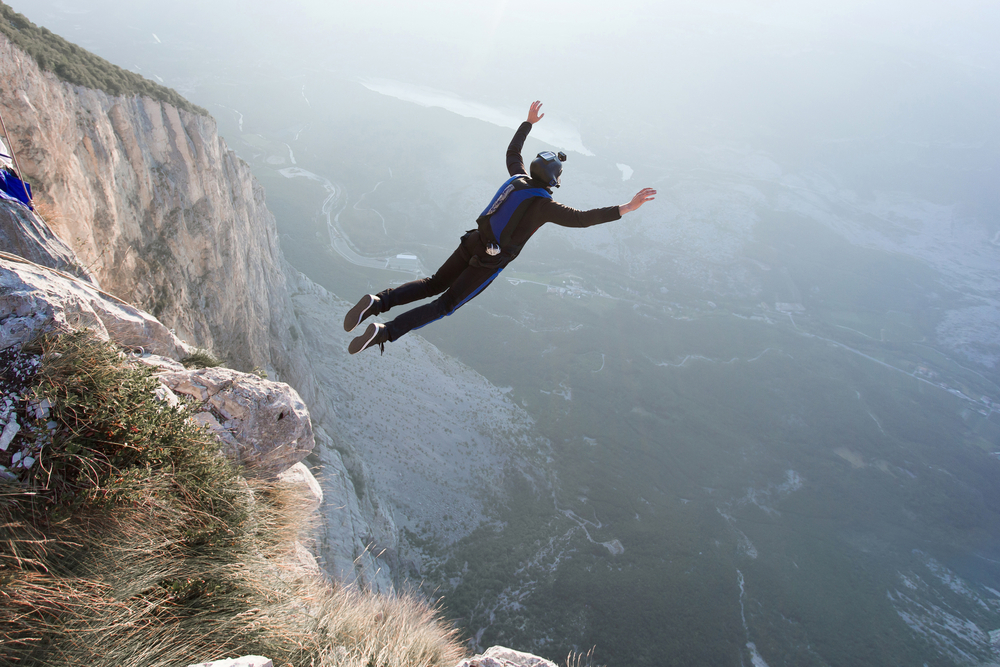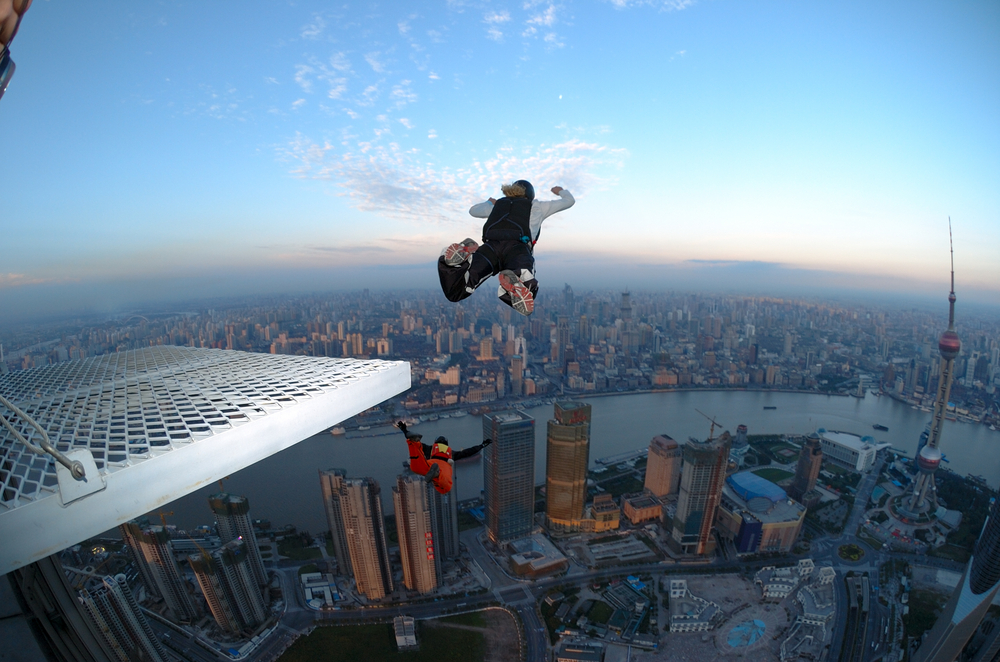Wait … aren’t skydiving and BASE jumping basically the same thing? Nope! The skydiving vs. BASE jumping debate boasts some significant differences, such as the type of gear used, the mentality behind the jump, and the requirements to get started. Let’s dive into the differences (and talk about why skydiving is the superior sport)!
What Is BASE Jumping?
BASE jumping entails jumping from a stable object, while skydiving is a jump from a moving aircraft. BASE is an acronym – it stands for Building Antenna Span (bridges) Earth (cliffs), which are the most commonly jumped from objects in the BASE world. BASE jumping is significantly more risky than skydiving for many reasons –- the jumper is super close to obstacles (unlike the openness of the great blue sky), has only one parachute, and has to maneuver their parachute to some pretty skinny landing areas to name a few.

Do You Need To Skydive To BASE Jump?
Yes! Have you seen those absolutely wild videos of professionals jumping from mountaintops and seamlessly careening their wingsuits through the ridges and crests? They all started as baby bird skydiving students! Reputable BASE jumping schools/instructors require a minimum number of skydives to have been completed by their prospective students; this number is typically between 200 and 500 skydives.
We would like to note that BASE jumping is a serious undertaking and the more jumps you have, the more confidence and competence you will have, which is critical to heighten your chances of success. Why must skydiving come first? Safety! BASE jumpers (kind of) and skydivers put safety first on every single jump.
The biggest physical similarity between skydiving and BASE jumping is mastering the art of stability. When a novice skydiver goes through the student progression, the ability to regain stability is a must-have to gain a skydiving license. This means, no matter what, that skydiver demonstrates the ability to take control of their body and show complete awareness. If a BASE jumper has a split second of hesitation and deploys their canopy while unstable, the results can be detrimental. Ensuring the person pursuing BASE is comfortable and confident, but not complacent, in the sky is an absolute must.
Do BASE Jumpers Have Backup Parachutes?
No, BASE rigs include one parachute. Skydiving rigs, on the other hand, include two parachutes — a main canopy and a reserve canopy. Skydiving rigs also include a Reserve Static Line (RSL) and an Automatic Activation Device (AAD) – two nifty life-saving devices!
Another difference between BASE jumping parachutes and skydiving parachutes is their functionality. BASE canopies are designed for one purpose: open fast and on heading. BASE jumpers have very little amount of time to correct their main canopy if it opens in a less-than-ideal way, so prioritizing those features is key. The main canopies used in skydiving are available in multiple designs, each possessing certain features for whichever skydiving discipline the jumper is pursuing. If you want to learn to swoop and go fast, there are parachutes designed specifically for that! If you want to work on building canopy formations in the sky with your friends and landing super accurately, the industry has you covered. Skydiving canopies are built to be safe and fun, and to suit your creative outlet. The reserve parachute in a skydiving rig is similar to a BASE canopy, as its sole function is to open fast and get to work!
- What are the altitude differences between BASE jumping and skydiving? At WNY Skydiving we regularly jump from a standard 10,000 feet (with the possibility to upgrade to 14,000 feet!), and skydivers typically deploy their parachutes between 3,000 and 5,000 feet. In contrast, BASE jumpers usually jump from heights of 300 to 2,000 feet! To visualize this, a football field (without the endzones) is about 300 feet –- WILD.
Is Skydiving Better Than BASE Jumping?
We’re biased … but, yes! The primary difference between the skydiving and BASE mentality is having the confidence that you’ll jump again. Let us explain. Skydivers go up on each load with the intent to pack up and get on the next load, jump the next day, or plan for the following weekend. BASE jumpers go up on every jump with the understanding that it may be their last. We never intend to diss our BASE jumping brothers and sisters, but in our minds, that type of risk is simply not worth the reward!
Let’s get mathy and look at some BASE jumping vs. skydiving statistics. BASE jumping has a fatality rate of about 1 in 2,300, while in 2022, skydiving had a fatality rate of about 1 in 195,000. We would like to note that the fatality rate for tandem skydiving is wayyy lower than this, coming in at around 1 in every 500,000!

I Still Think BASE Sounds Awesome, Where Do I Start?
The first step in any BASE jumping journey is to gain a skydiving license. After reaching a minimum of 200 jumps, it’s generally acceptable to start asking around your dropzone and getting acquainted with avid BASE jumpers. The skydiving and BASE jumping communities are adjacent and both generous; if someone doesn’t know the answer you’re searching for, chances are they can get you in touch with someone who can guide you in the right direction!
Whether you’re bound for BASE jumping or want to flock to the skies from airplanes, book your tandem skydive and start your jumping journey today! Blue skies!





